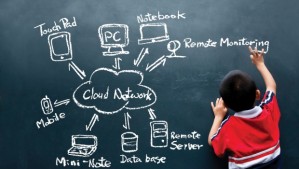Meghan Bogardus Cortez outlined her top four K-12 education trends for 2017. Meghan is an associate editor with EdTech: Focus on K–12. She enjoys following all the ways technology is constantly changing our world.
K–12 Google Chromebook sales surpassing 51 percent. President Obama declaring that computer science is for all. An explosion of augmented reality and virtual reality. In 2016, teachers, administrators and students truly were on the front lines of incredible tech innovation.
The good news is that all of this new technology didn’t deter educators from dabbling and experimenting with it. For example, last year teachers said they were more comfortable using technology than ever before. Twenty-four percent of teachers surveyed by Education Week even said they considered themselves to be “risk takers” in terms of tech use.
Here are four education technology issues that took center stage in 2016 and are sure to be trending in 2017:
1. Creating Future-Ready Networks for Future-Ready Students
Preparing students for the tech-based workforce proved to be an ongoing impetus for the future of K–12 education. However, this requires an influx of technology, such as the massive one-to-one Chromebook deployment for example.
A robust infrastructure — including strong wireless networks — is a requirement for supporting and sustaining any updates to education technology. Building a strong, scalable network is the first step to establishing a future-ready school. But schools should always be ready to change both their thinking and their networks for whatever the future brings.
Conversations schools are having now can not only impact the ‘now,’ but also are part of the future.
Another component of getting students ready for the future is making sure they are using tech as they might in the real world. GK thinks this is a huge reason to create a ubiquitous network. However, this can also be done with a shifting of the curriculum.
With Common Core Standards requiring that students employ technology and use devices with tremendous computing power, K–12 schools are getting even closer to recreating the working environments of the real world.
2. Embracing Computer Science Education for All Students
President Obama began 2016 by declaring computer science education to be a huge priority for U.S. schools looking to prepare students for the digital economy.
“In the coming years, we should build on that progress, by … offering every student the hands-on computer science and math classes that make them job-ready on day one,” the president said in his 2016 State of the Union address.
This program began as a means to address the lack of diversity in many tech fields.
Less than 10 percent of computer scientists are African-American or Hispanic, and only 18 percent of women major in computer science at colleges and universities, the National Science Foundation reveals.
Some educators have embraced computational thinking — thinking like a computer and using concepts of computer science to solve problems — with and without technology in order to demystify the topic for the youngest of students. Tech tools like the Minecraft: Education Edition have also given students the benefit of learning engineering skills through play.
The concept of computational thinking was also embraced by The College Board when they created AP Computer Science Principles, a high school course designed make the topic accessible for more students than ever before. The course, which launched last fall, experienced the largest AP course launch ever, with over 25,000 students participating.
3. The Power of Personalized Learning Through Tech
Technology has also allowed more teachers to provide a personalized learning experience for their students, something that New Media Consortium identified as a growing factor in embracing ed tech.
GK’s Jigsaw virtual learning platform is similar the the one used at Arlington Public Schools in suburban Washington, D.C., The platform offers the ability to collect data and get live feedback from students and teachers has fueled more engagement because students are able to choose how they learn.
The platform is the perfect tool to allow each student to take charge of his or her learning experience. Additionally, more accountability has provided better learning outcomes. Technology allows teachers to be in multiple places at a time.
4. The Virtual Future of Immersive Education
Thanks to the explosion in popularity of Pokémon Go last summer, augmented reality and virtual reality have been huge buzzwords in the education world this year.
A survey found that an overwhelming 85 percent of teachers think VR is beneficial for their classrooms, but only 2 percent are currently using it. Inroads are being made as more tools come out — and make VR application a real possibility. GK is creating its first VR music book and curriculum this year.

